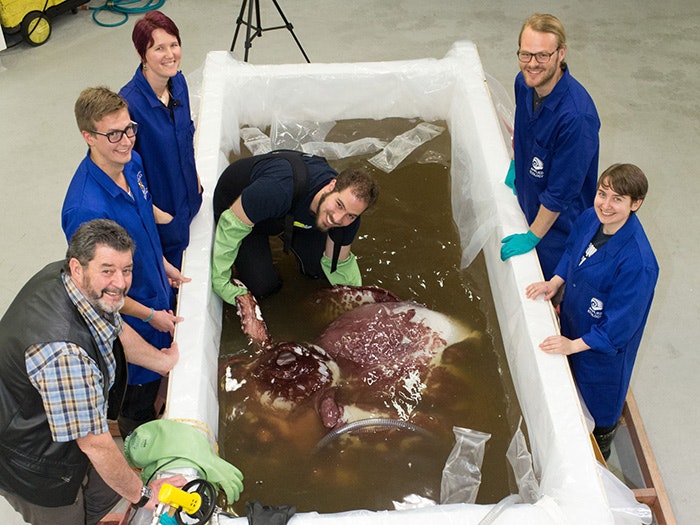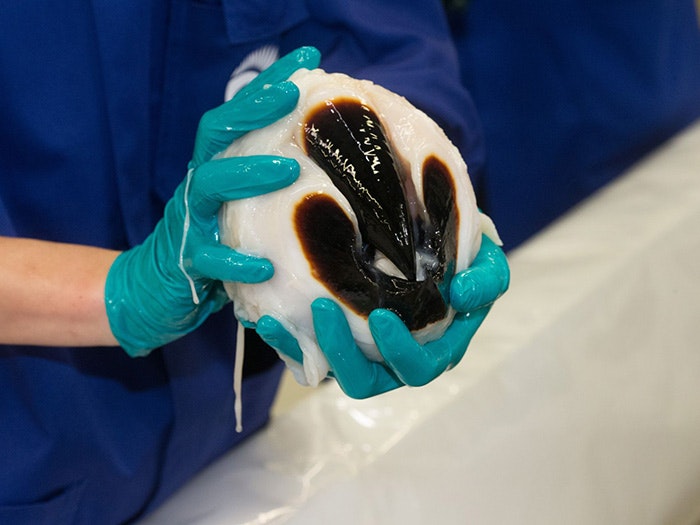
Watch: Highlights from a colossal squid examination
Watch highlights from a colossal squid examination at Te Papa as specialists in squid biology from Auckland University of Technology undertake research on this rare find.
‘I never dreamed that one day I would get to come face to face with a real colossal squid. These animals are the stuff of legend and it’s quite surreal to get to study one first-hand.’ – Aaron Boyd Evans, cephalopod scientist.
_____
Dr Kat Bolstad and Aaron Boyd Evans measure a colossal squid arm, 2014. Photograph by Norm Heke. Te Papa
To study colossal squid, you have to get up close. There's always room for a scientist in the tank!
_____
Scientists from Auckland University of Technology and Otago University, along with John Bennett, skipper of the San Aspiring, at the colossal squid examination, 2014. Photograph by Norm Heke. Te Papa
Although colossal squid are huge, there are still plenty of small parts to count. Aaron Boyd Evans counts the arm suckers, which squid use to tightly grip their prey. Scientists were interested to find the number of arm suckers was not the same as on the colossal squid dissected in 2008. This suggests that arm suckers might not be uniform across all colossal squid.
_____
Aaron Boyd Evans counting colossal squid arm suckers, 2014. Photograph by Norm Heke. Te Papa
Scientists extracted the huge parrot-like beak, and the muscle tissue surrounding it, for further examination at Auckland University of Technology and Otago University. Researchers can use this beak to find out more about the colossal squid’s biology and life history, including the age of the animal.
_____
Dr Kat Bolstad and Tyler Northern show the colossal squid beak to John Bennett, 2014. Photograph by Norm Heke. Te Papa
The colossal squid holds the record for the world's biggest eye. At 37 centimetres across, the eyes from this specimen are the biggest animal eyes ever found. Scientists from Auckland University of Technology are taking the eyes back to the lab to find out more about how they work, and how they evolved.
_____
Dr Kat Bolstad holding the lens from a colossal squid eye, 2014. Photograph by Norm Heke. Te Papa
Measurements taken during the examination are just the start of the scientific knowledge that will be gained from this specimen. Samples were taken for further analysis in labs across New Zealand. Muscle tissue and stomach contents will be examined to see what the colossal squid eats. Hooks and suckers will be studied to see what effect ocean acidification might have on deep-ocean-dwelling invertebrates. The specimen will be compared to other similar species, to learn more about how squid are related.
_____
Taking samples from colossal squid suckers, 2014. Photograph by Norm Heke. Te Papa
Museum specimens like the colossal squid are preserved for the information they hold. Like a book in the library, a specimen can be 'read' many times, with new information being discovered each time.
Who knows what this colossal squid might reveal to researchers in the future!
_____
Scientists from Auckland University of Technology and Otago University examine the colossal squid, 2014. Photograph by Scott Ogilvie. Te Papa
You might also like


The anatomy of the colossal squid
Discover all about the anatomy this deep sea beast. Learn about it's massive eyes, sharp beak, and long hooked tentacles.